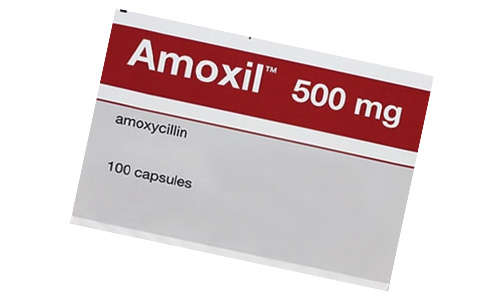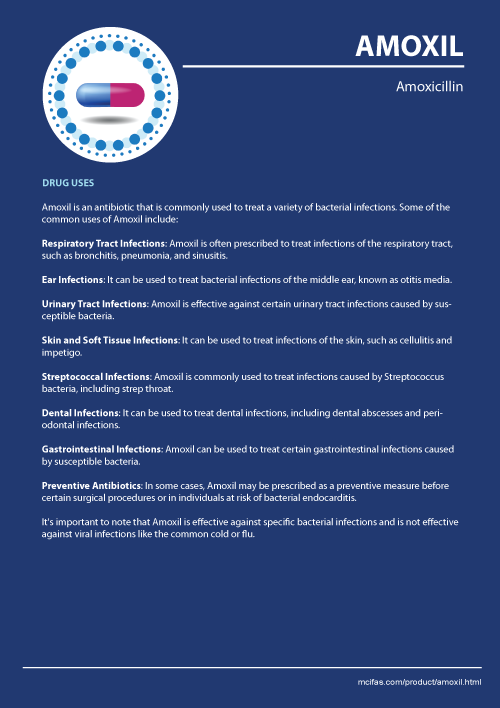Amoxil Prescribing Information
Amoxil is a brand name for the antibiotic amoxicillin, which belongs to the penicillin class of antibiotics. It is commonly used to treat a variety of bacterial infections, such as respiratory tract infections, ear infections, urinary tract infections, and skin infections. Amoxicillin works by inhibiting the growth of bacteria and interfering with their cell wall synthesis.

Uses of Amoxil
Amoxil is an antibiotic that is commonly used to treat a variety of bacterial infections. Some of the common uses include:
- Respiratory Tract Infections: Medicine is often prescribed to treat infections of the respiratory tract, such as bronchitis, pneumonia, and sinusitis.
- Ear Infections: It can be used to treat bacterial infections of the middle ear, known as otitis media.
- Urinary Tract Infections: Amoxil is effective against certain urinary tract infections caused by susceptible bacteria.
- Skin and Soft Tissue Infections: It can be used to treat infections of the skin, such as cellulitis and impetigo.
- Streptococcal Infections: Antibiotic is commonly used to treat infections caused by Streptococcus bacteria, including strep throat.
- Dental Infections: It can be used to treat dental infections, including dental abscesses and periodontal infections.
- Gastrointestinal Infections: Amoxil can be used to treat certain gastrointestinal infections caused by susceptible bacteria.
- Preventive Antibiotics: In some cases, drug may be prescribed as a preventive measure before certain surgical procedures or in individuals at risk of bacterial endocarditis.
It's important to note that Amoxil is effective against specific bacterial infections and is not effective against viral infections like the common cold or flu.
Dosage
The dosage of Amoxil can vary depending on the type of infection being treated, the patient's age and weight, and other individual factors. It's important to follow the dosage instructions provided on the prescription label. The following are general guidelines for this drug dosages:
Adults:
- Typical Dose: 250 mg to 500 mg every 8 hours, or 500 mg to 875 mg every 12 hours, depending on the severity of the infection.
- Maximum Dose: In most cases, the maximum recommended dose of amoxicillin is 6 grams per day.
Children:
- Dosage is usually based on the child's weight and is typically around 20-45 mg per kg of body weight per day, divided into two to three doses.
Side Effects
Amoxil is generally well-tolerated, but like any medication, it can have side effects. Common side effects may include:
- Gastrointestinal Distress: Nausea, vomiting, diarrhea, and stomach discomfort are common side effects. Taking the medication with food can help reduce these symptoms.
- Allergic Reactions: Some individuals may experience allergic reactions, including rash, itching, swelling, and in severe cases, difficulty breathing. If you notice any signs of an allergic reaction, seek medical attention immediately.
- Yeast Infections: Amoxicillin can disrupt the balance of natural bacteria in the body, leading to yeast overgrowth and the development of yeast infections, particularly in the mouth (oral thrush) or genital area.
- Skin Reactions: Skin rashes and hives can occur as a reaction to the medication. Stop taking Amoxil and consult your doctor if you develop a rash.
- Pseudomembranous Colitis: In some cases, the use of antibiotics like Amoxil can lead to a condition called pseudomembranous colitis, which is characterized by severe diarrhea, abdominal pain, and fever. If you experience these symptoms, seek medical attention.
- Blood Disorders: Rarely, Amoxil can affect blood cells, leading to conditions like leukopenia (low white blood cell count) or thrombocytopenia (low platelet count).
- Central Nervous System Effects: Some individuals might experience nervousness, agitation, or confusion.
- Liver Function: Medicine can affect liver function in rare cases, leading to elevated liver enzymes or hepatitis.
- Kidney Function: In rare instances, Amoxil can affect kidney function, causing changes in urine output or kidney inflammation.
- Hypersensitivity Reactions: Severe allergic reactions, such as anaphylaxis, can occur in rare cases. These reactions can be life-threatening and require immediate medical attention.
Remember that this list is not exhaustive, and the actual side effects experienced can vary from person to person.
Interaction with other drugs
Amoxil can interact with other drugs, which can affect its effectiveness, increase the risk of side effects, or lead to potentially harmful interactions. Here are some examples of interactions:
- Probenecid: Probenecid can increase the levels of amoxicillin in the body by reducing its elimination. This can lead to higher concentrations of the antibiotic, potentially increasing the risk of side effects.
- Allopurinol: Allopurinol, a medication used to treat gout, can increase the risk of rash when taken with amoxicillin.
- Oral Contraceptives: Amoxicillin may reduce the effectiveness of oral contraceptives, potentially leading to an increased risk of unintended pregnancy. Additional contraceptive measures may be needed while taking amoxicillin.
- Methotrexate: Concurrent use of methotrexate and amoxicillin can lead to increased levels of methotrexate in the body, potentially increasing its toxic effects.
- Anticoagulants (Warfarin): Amoxicillin can affect the effectiveness of anticoagulant medications by altering their metabolism, potentially leading to an increased risk of bleeding.
- Other Antibiotics: Concurrent use of multiple antibiotics can sometimes lead to interactions or changes in effectiveness.
- Live Bacterial Vaccines: Amoxicillin can potentially interfere with the effectiveness of live bacterial vaccines.
- Methotrexate: There is a possibility that amoxicillin could increase the risk of methotrexate toxicity.
What to avoid while on Amoxil
While taking Amoxil, there are certain things you should avoid or be cautious about to ensure the effectiveness of the medication and minimize the risk of potential interactions or side effects. Here are some recommendations:
- Alcohol: It's generally recommended to avoid alcohol while taking antibiotics, including Amoxil. Alcohol can potentially interfere with the antibiotic's effectiveness and may also exacerbate certain side effects, such as gastrointestinal discomfort.
- Grapefruit and Grapefruit Juice: Grapefruit and grapefruit juice can interact with some medications, potentially affecting their absorption and metabolism. While amoxicillin is not specifically known to interact with grapefruit, it's a good practice to avoid consuming large amounts of grapefruit or grapefruit juice while on medication.
- Antacids and Calcium Supplements: Certain antacids and calcium supplements can interfere with the absorption of amoxicillin. If you need to take an antacid or calcium supplement, it's best to do so at least 2 hours before or after taking Amoxil.
- Dairy Products: While not a direct interaction, consuming dairy products close to the time of taking Amoxil can sometimes reduce its absorption. To minimize this effect, it's advisable to take Amoxil at least 1 to 2 hours before or after consuming dairy products.
- Other Medications: Some medications can interact with amoxicillin and may need to be adjusted or temporarily stopped.
- Birth Control Pills: Amoxicillin may reduce the effectiveness of birth control pills. If you are using oral contraceptives, consider using additional contraceptive methods while taking Amoxil and for a short time afterward to ensure protection against unintended pregnancy.
- Driving and Operating Machinery: Some people may experience dizziness or confusion as a side effect of Amoxil. If you experience these effects, it's advisable to avoid activities that require alertness, such as driving or operating heavy machinery, until you know how the medication affects you.
Contraindications of Amoxil
Amoxil has certain contraindications, which are specific situations or conditions where the use of the medication is not recommended due to potential risks or lack of efficacy. Here are some common contraindications:
- Allergy to Penicillin or Beta-Lactam Antibiotics: If you have a known allergy to penicillin antibiotics or other beta-lactam antibiotics (such as cephalosporins), you should avoid using Amoxil, as there is a risk of an allergic reaction. Inform your doctor about any allergies you have.
- Severe Allergic Reactions in the Past: If you have experienced severe allergic reactions, such as anaphylaxis, to amoxicillin or other antibiotics, Amoxil should be avoided.
- Infectious Mononucleosis: Amoxil should be avoided in patients with infectious mononucleosis (commonly known as mono) because it can cause a rash in individuals with this condition.
- Liver Dysfunction: Individuals with severe liver dysfunction or history of liver disease may need to avoid or use this medicine with caution, as the medication is primarily eliminated through the liver.
- Kidney Dysfunction: People with severe kidney dysfunction may need dosage adjustments or closer monitoring when using Amoxil.
- History of Gastrointestinal Disease: Individuals with a history of gastrointestinal disease, particularly colitis, should use Amoxil with caution as the medication may worsen certain gastrointestinal conditions.
- Certain Medical Conditions: Conditions such as asthma, hay fever, and hives may increase the risk of an allergic reaction to amoxicillin.
- Certain Medications: Some medications, such as allopurinol, can increase the risk of rash when taken with amoxicillin.
- Methotrexate Use: Amoxicillin can interfere with the elimination of methotrexate, a medication used for various conditions, potentially leading to toxic effects.
Pregnancy and Amoxil
Antibiotic is generally considered safe to use during pregnancy when it's prescribed by a healthcare professional and the potential benefits outweigh the potential risks. However, like any medication, there are factors to consider when using Amoxil during pregnancy:
- Consultation with Healthcare Provider: If you are pregnant or planning to become pregnant, it's important to discuss the use of Amoxil with your healthcare provider. They will consider your individual medical history, the severity of the infection, and the potential benefits and risks of the medication.
- Infection Severity: In some cases, the potential risks of leaving an infection untreated during pregnancy may outweigh any potential risks associated with the use of antibiotics like Amoxil. Serious bacterial infections can pose risks to both the mother and the developing fetus.
- Safety Profile: Amoxicillin is often considered one of the safer antibiotics to use during pregnancy. It is a category B medication according to the U.S. Food and Drug Administration (FDA) pregnancy categories, which means that animal studies have not shown a risk to the fetus, and there are no well-controlled human studies. However, individual responses can vary.
- Allergic Reactions: If you have a known allergy to penicillin antibiotics, including amoxicillin, you should inform your doctor. Allergic reactions can be serious and may impact both the mother and the baby.
- Breastfeeding: Amoxicillin can pass into breast milk in small amounts, but it is generally considered safe for use while breastfeeding.
» Drug Uses (format pdf, 0.2 Mb)



